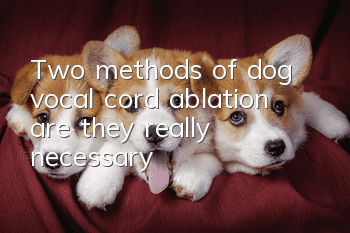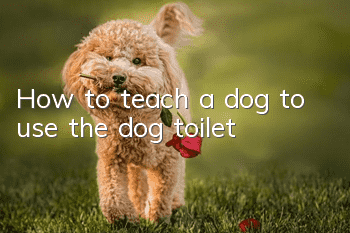Two methods of dog vocal cord ablation, are they really necessary?

1. The necessity and appropriate age of dog vocal cord removal
With the improvement of social civilization, people's awareness of animal protection is also increasing day by day. While dogs have entered thousands of households as pets, humanistic and moral concepts have also penetrated into the rising pet breeding industry. However, in order to avoid causing noise pollution to the neighborhood environment or to keep their own homes quiet, some owners have no choice but to perform sound-silencing surgery on their pets. Some owners wear silencer collars on their dogs. The electrical stimulation emitted by the collar punishes the dog's barking and does not cause any damage to the dog's body. Although the noise-canceling collar can protect the dog from the skin pain of surgery, it will change the dog's normal behavior in the long run. For this reason, the author advocates performing muffler surgery on dogs that like to bark and seriously affect the surrounding environment. The muffler effect will be more reliable, will not cause long-term stimulation to the dog, and will not affect the dog's other living habits. It is generally believed that the base of the vocal cords of dogs under 6 months of age is not fully developed and is not suitable for vocal cord resection. If a dog under 6 months of age undergoes vocal cord resection, the epithelial cells of the vocal cord mucosa are more likely to regenerate after surgery, and incomplete silencing and voice recovery often occur.
2. Surgical approach
A. Ventral ventricular vocal cord resection
Anesthesia and Baoding In order to prevent dogs from vomiting after surgery, they should fast for 10 to 12 hours before surgery and stop drinking water within 2 hours. Inject atropine 0.05mg/kg intramuscularly 15 minutes before anesthesia to relax smooth muscles, inhibit gland secretion, reduce the secretion of respiratory mucus and salivary glands, and help keep the respiratory tract open; inhibit the vagal reflex, increase the heart rate, and are used to eliminate Side effects such as abnormalities in the cardiovascular system and respiratory system caused by parasympathetic nerve excitement caused by anesthetic drugs. The anesthetic was selected as Sumianxin injection at a dose of 0.01 mg/kg for intramuscular injection.
The dog is placed in a supine position, and the head is stabilized while maintaining tension in the neck to protrude the Adam's apple, which is conducive to accurate positioning of the surgical site and full exposure of the vocal cords after incision of the thyroid cartilage. Do not raise the dog's neck too high, otherwise it will cause respiratory depression or intraoperative bleeding into the deep trachea.
The surgical procedure takes the thyroid cartilage protrusion as the center of the incision, and the skin is incised 6cm in the midline (can be adjusted according to the individual size of the dog). Carefully separate the sternohyoid muscles to reduce bleeding. For young dogs of average size, when the thyroid cartilage is not very hard, cut the thyroid cartilage longitudinally about 3cm. The assistant uses a small wound hook to retract the thyroid cartilage to both sides to fully expose the vocal cords. The surgeon holds one side of the vocal cord with an elbow hemostat in one hand, and a blunt-edged surgical scissor in the other hand (should not be large), so that the curved part of the scissors follows the inner wall of the thyroid cartilage to completely cut off the vocal cord. Cut away as much vocal cord tissue as possible, including vocal ligaments and vocal cord muscles. Use the curved heads of the hemostats and scissors to clamp and cut the vocal cords respectively, and avoid branches near the laryngeal artery. Spraying 2% lidocaine into the laryngeal chamber for topical anesthesia can reduce the irritation of the wound in the laryngeal chamber. After removing the vocal cords, soak theApply pressure with a cotton ball containing 0.1% epinephrine for about 10 seconds. In the event of severe bleeding such as laryngeal artery branch injury, cautery hemostasis can be used to stop bleeding, and tracheal intubation can be performed after surgery to inflate the cuff on the intubation tube to compress the bleeding site to stop bleeding. If there is blood or a large amount of secretions in the trachea, the dog's head should be lowered to facilitate the removal of foreign matter in the trachea, or it can be sucked out through an endotracheal intubation.
When suturing the thyroid cartilage wound edge intermittently, there is no significant difference in the effects of suturing methods that penetrate the full thickness and do not penetrate the mucosal layer. The author believes that suturing without penetrating the mucosal layer can reduce the irritation of the wound from the inside of the trachea. and the chance of infection. When suturing, the edges of the cartilage wounds should be closely aligned to prevent infection caused by laryngeal ventricular airflow rushing out of the incision and penetrating into the subcutaneous tissue. Generally, a 2/3 arc curved triangular needle and No. 4 silk thread (absorbable thread is better) are used for suturing.
B. Transoral vocal cord resection
Open the mouth, pull the tongue out of the mouth, and use a laryngoscope to press the base of the tongue and the tip of the epiglottis cartilage to expose the vocal cords on both sides. First, use long-handled tissue forceps to clamp the dorsal side of the vocal cords in sequence, and then use long blunt-tipped curved surgical scissors to cut off the clamped vocal cords.
3. Comparison of the pros and cons of ventral laryngeal ventricular vocal cord resection and transoral vocal cord resection
1. The procedure of transoral resection of the vocal cords is simple and eliminates the need for tissue incision and suturing. However, it has the disadvantages of being difficult to operate, high risk, and incomplete silencing. Transoral vocal cord resection requires a certain level of surgical proficiency and skill. Because the "V" shaped vocal cord is located at the base of the ventral surface of the larynx, when resecting it through the mouth, it needs to be clamped with long-handled instrument pliers, and then long scissors are used to cut it out in the small space of the laryngeal chamber; the operation must be fast and accurate. To avoid repeated pinching of the epiglottis cartilage for a long time, which may lead to laryngeal edema and difficulty in breathing.
2. The risk of transoral vocal cord resection is that it is easy to damage the branches of the laryngeal artery and is difficult to stop bleeding. Intraoperative bleeding required postoperative tracheal intubation.
3. It is not easy to completely remove the vocal cords through the mouth, resulting in incomplete silencing by this method. Some people have also proposed using direct intraoral cauterization to destroy the vocal cords, and its silencing effect deserves further confirmation.
4. The surgical route of lateral laryngeal ventricle vocal cord resection has less bleeding, can fully expose the vocal cords, facilitates complete resection, ensures sound attenuation, and completely stops bleeding after removing the vocal cords.
4. Postoperative care and prognosis
After surgery, the same amount of Suxingling injection as the anesthetic is injected to revive the dog in time. After releasing the Baoding, the dog should be in a prone position with its head slightly lowered until no blood flows out. After waking up, excessive secretions in the trachea or blood flowing out during surgery will be coughed up, which plays a certain role in eliminating foreign bodies in the trachea.
After surgery, keep the dog as quiet as possible to reduce external stimulation and avoid causing the dog to bark and affect wound healing. To reduce barking and prevent coughing, sedatives and cough suppressants are availableagent. Antibiotics were administered to prevent infection for 3 days. If the dog shows discomfort in swallowing within 1 to 2 days after the operation, he should be fed liquid food. The sutures were removed 8 to 10 days after surgery.
The 1/4 of the vocal cords at the joint of the vocal cords on both sides of the ventral laryngeal chamber should not be cut off. After cutting, scar tissue can proliferate and cross the glottis to form a fibrous web, causing functional changes in the structure of the laryngeal chamber. In order to reduce the proliferation of scar tissue after vocal cord resection, prednisolone 2mg/kg can be used for 2 weeks after surgery.
Three months after the dog's silencing, the wound in the vocal cord resection area has been basically covered by epithelium. Sheet-like membranous tissue will grow from the laryngeal wall, which resembles the vocal cords, and has the function of adduction and abduction with the movement of the arytenoid area. This is called vocal cord reconstruction. The reconstructed vocal cords are mainly composed of connective tissue transformed from granulation tissue. Fibroblasts are the most numerous cells in this connective tissue. Due to their strong regenerative ability, they can rapidly respond to injury with proliferation and fiber formation, thus becoming a major factor in repair.
Editor’s words: In fact, some dogs can be trained in formal training schools and their barking can be corrected in a timely and effective manner. Vocal cord removal surgery is only a surgical treatment when there is really no other way. What do you think?
- What happens when a cat vomits after eating? What should you do if a cat vomits?
- Australian Shepherd personality traits
- Can dogs eat mangosteen? Why?
- What should I do if my Labrador loses a lot of hair in summer?
- Does the Basenji have a high IQ and how does it shed? Is it expensive?
- Dogs don’t know how to defecate on time? Then you should train like this
- What are the training methods and precautions for small Shiba Inu?
- What's wrong with your dog sneezing? He's in good spirits.
- How long does it take for a dog to suffer from rat poison?
- Do golden retrievers have body odor? How to get rid of golden retriever body odor?



